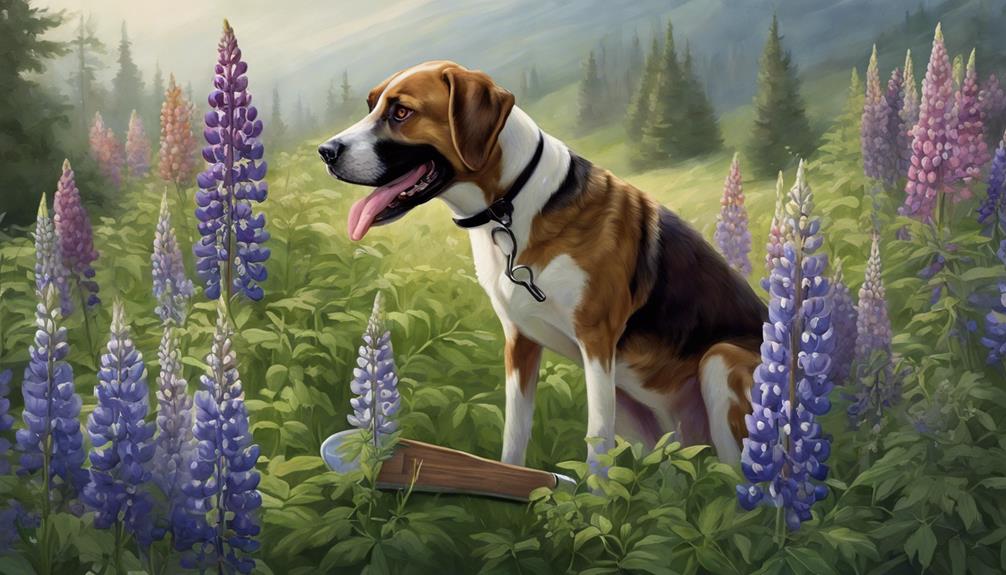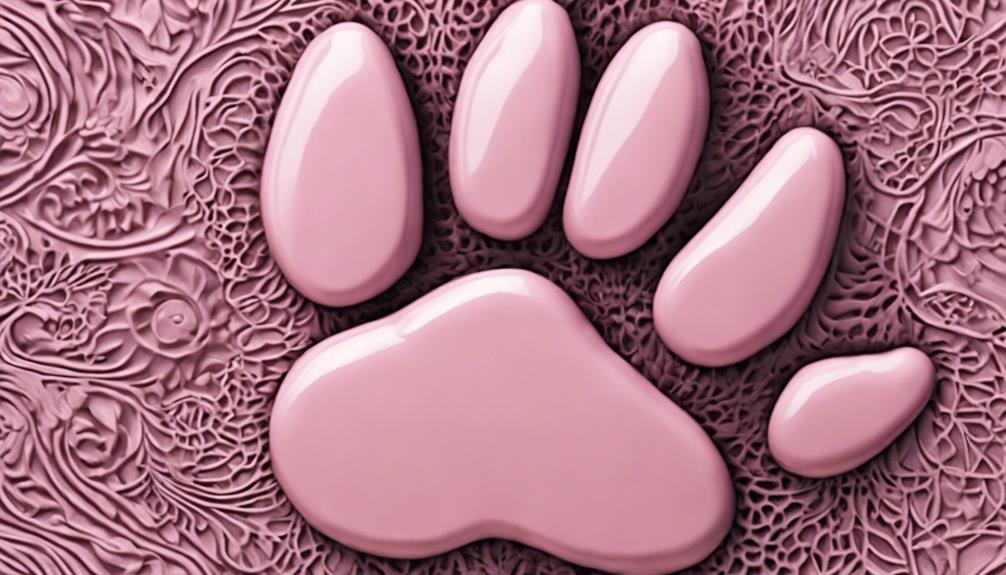When it comes to keeping your dog safe from plants like Wild Lupine, know the facts. Look for tall, spiked flowers in purple or pink in meadows and wooded areas. Lupines can harm dogs if eaten. Watch out for it where it grows. Keep a close eye, especially with pets around. Symptoms include loss of appetite, breathing issues, and frothing at the mouth. If your dog shows signs, act fast. Remove any leftovers from the mouth, give water, and call a vet. Understanding these dangers is key to protecting your furry friend. Further tips await understanding Lupine and safety measures.
Key Takeaways
- Identify tall, spiked flowers in purple to pink.
- Beware of toxicity if ingested by dogs.
- Look out for symptoms like loss of appetite and frothing.
- Take immediate action by removing plant material and contacting a vet.
- Prevent poisoning by supervising dogs and training them to avoid Lupine.
Identification and Awareness
When identifying Wild Lupine, look for its tall, spiked flowers that range from deep purple to pink. These striking plants can be found in various habitats, including meadows, prairies, and wooded areas.
While Wild Lupine adds beauty to these landscapes, it's important to be aware that they can be toxic to dogs if ingested. Being mindful of where Wild Lupine grows can help prevent accidental encounters with this plant.
In prairie and wooded areas where Wild Lupine thrives, keeping a close eye on your surroundings is essential, especially when accompanied by your furry friend.
Symptoms and Warning Signs

Loss of appetite, breathing difficulty, frothing at the mouth, nervousness, and loss of coordination are all potential symptoms and warning signs of lupine poisoning in dogs. If your furry friend displays any of these signs after potential exposure to the lupine plant, it could indicate pet poison and the need for immediate veterinary attention.
Loss of appetite may manifest as a disinterest in food or a sudden decrease in eating. Dogs experiencing breathing difficulty may show signs such as rapid breathing or panting excessively. Frothing at the mouth could be observed as excessive drooling or the presence of foam around the muzzle. Nervousness may cause your dog to act unusually anxious or agitated. Loss of coordination could be seen as stumbling, difficulty walking, or unsteady movements.
Recognizing these signs of toxicity early on and seeking prompt veterinary care is vital in ensuring the well-being of your beloved pet.
Immediate Action Steps

In case of Wild Lupine ingestion by your dog, promptly remove any remaining plant material from their mouth. Offering water can help wash down any remnants of the plant that were ingested.
It's essential to act quickly and contact a veterinarian or poison hotline. Providing details of the ingestion and any observed symptoms will assist in determining the best course of action. Remember that time is of the essence when dealing with potential poisoning.
Enzyme inhibitors present in Wild Lupine can affect your dog's heart rate, so swift action is essential. By reaching out for professional help promptly, you can receive guidance on what steps to take next. Vets may induce vomiting, administer activated charcoal, or offer supportive care to help your dog recover.
Following their instructions closely increases the chances of a successful outcome. Your quick response and adherence to professional advice are key to ensuring your dog's well-being in the event of Wild Lupine ingestion.
Veterinary Treatment Options

Our veterinary clinic offers a range of treatment options for lupine poisoning in dogs, including inducing vomiting to prevent further toxin absorption. If your dog has ingested lupine or other toxic plants, it's important to seek prompt veterinary care.
Intravenous fluids may be administered to support hydration and help flush out toxins from the system. Anti-seizure medications can also be given to control any seizures that may occur as a result of lupine poisoning.
Since there's no specific antidote available for lupine poisoning, supportive care plays a crucial role in the treatment process. This may include monitoring vital signs, providing oxygen therapy if needed, and offering nutritional support.
Prevention and Safety Measures

To safeguard your dog from lupine poisoning, it's important to implement effective prevention and safety measures. In western states and provinces where Wild Lupine is prevalent, it's vital to be vigilant in wooded areas and open spaces.
Train your dog to avoid Wild Lupine by using commands like 'leave it' and rewarding obedience. Supervise your dog when in areas where Wild Lupine grows, or create dog-proofed zones to minimize the risk of ingestion.
Educate yourself on the appearance of Wild Lupine in different seasons to prevent accidental consumption by your dog. Implement prevention strategies such as crate training to keep your dog away from plants known to be toxic, like Wild Lupine.
Utilize resources like Greg for quick identification of harmful plants. By following these measures, you can help guarantee your dog's safety and well-being in environments where Wild Lupine may pose a threat.
Frequently Asked Questions
How Toxic Are Lupins to Dogs?
Lupines are highly toxic to dogs, containing alkaloid lupinine and enzyme inhibitors. Ingestion can lead to severe symptoms like loss of appetite, breathing difficulty, and convulsions.
If your dog consumes lupines, contact a vet immediately for advice and check-up. Treatment for lupine poisoning is mainly supportive since there's no antidote available.
Always keep lupines away from pets to prevent accidental ingestion and potential harm.
How Toxic Are Lupines?
Lupines are harmful to dogs due to alkaloids causing symptoms like loss of coordination and muscle twitching. Serious effects include loss of appetite, breathing problems, and convulsions. Veterinarian contact is essential if lupine ingestion is suspected.
Treatment for lupine poisoning in dogs is supportive, lacking an antidote. Immediate care is important for a dog's well-being in case of lupine ingestion.
Are Lupins Poisonous to Touch?
Lupins are generally safe to touch, but the main concern lies in ingestion, especially for dogs. While skin irritation from direct contact is rare, washing hands after handling them is wise.
For safety, focus on preventing dogs from eating lupins, as ingestion poses the greatest risk. Remember, the toxins in lupins are typically harmful when consumed, not when touched.
Which Lupine Are Not Poisonous?
Some lupine species, like Lupinus perennis, aren't toxic to dogs. It's vital to identify safe lupine varieties to safeguard our pets.
Lupines can be found in various habitats and regions, making it essential to know which ones are non-poisonous. By understanding the difference between poisonous and non-poisonous lupines, we can guarantee our furry friends' safety.
It's always best to err on the side of caution when it comes to our pets' well-being.
Conclusion
In summary, it's vital to always be watchful and cautious when it comes to keeping your furry companions safe from toxic plants like lupine. Remember, prevention is essential to avoiding potential dangers.
By being mindful of the symptoms and taking immediate action if necessary, you can guarantee the well-being of your beloved pets.
Let's all aim to create a home environment that's free from harmful substances, just like we'd protect our own family members.









